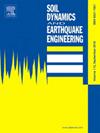Experimental and numerical simulation analyses of a displacement-dependent self-centering variable friction damper
IF 4.2
2区 工程技术
Q1 ENGINEERING, GEOLOGICAL
引用次数: 0
Abstract
A displacement-dependent self-centering variable friction damper (DSVFD) was proposed to mitigate the residual displacement of structures following seismic events by utilizing the self-centering capabilities of a disc spring group and the energy dissipation features of a stepped friction plate. Cyclic loading tests coupled with finite element analyses were conducted to examine the impacts of the friction plate preload, loading displacement amplitude, and number of loading cycles on the damper's self-centering and energy dissipation behaviors. These findings suggest that increasing the friction plate preload improves the energy dissipation capacity of the damper, although it adversely affects the self-centering rate. Increasing the loading displacement significantly increased the energy dissipation, whereas increasing the number of loading cycles had a negligible effect on the performance. A comparison between the experimental results, considering various friction disc preloads, and the numerical simulations demonstrates a strong correlation. Further parametric analyses revealed that increasing the inclination angle of the friction plate increased the peak load, loading stiffness, and self-centering capability of the DSVFD. Additionally, an increase in the kinetic friction coefficient between the friction plates enhances energy dissipation but diminishes the self-centering ability of the damper.
求助全文
约1分钟内获得全文
求助全文
来源期刊

Soil Dynamics and Earthquake Engineering
工程技术-地球科学综合
CiteScore
7.50
自引率
15.00%
发文量
446
审稿时长
8 months
期刊介绍:
The journal aims to encourage and enhance the role of mechanics and other disciplines as they relate to earthquake engineering by providing opportunities for the publication of the work of applied mathematicians, engineers and other applied scientists involved in solving problems closely related to the field of earthquake engineering and geotechnical earthquake engineering.
Emphasis is placed on new concepts and techniques, but case histories will also be published if they enhance the presentation and understanding of new technical concepts.
 求助内容:
求助内容: 应助结果提醒方式:
应助结果提醒方式:


